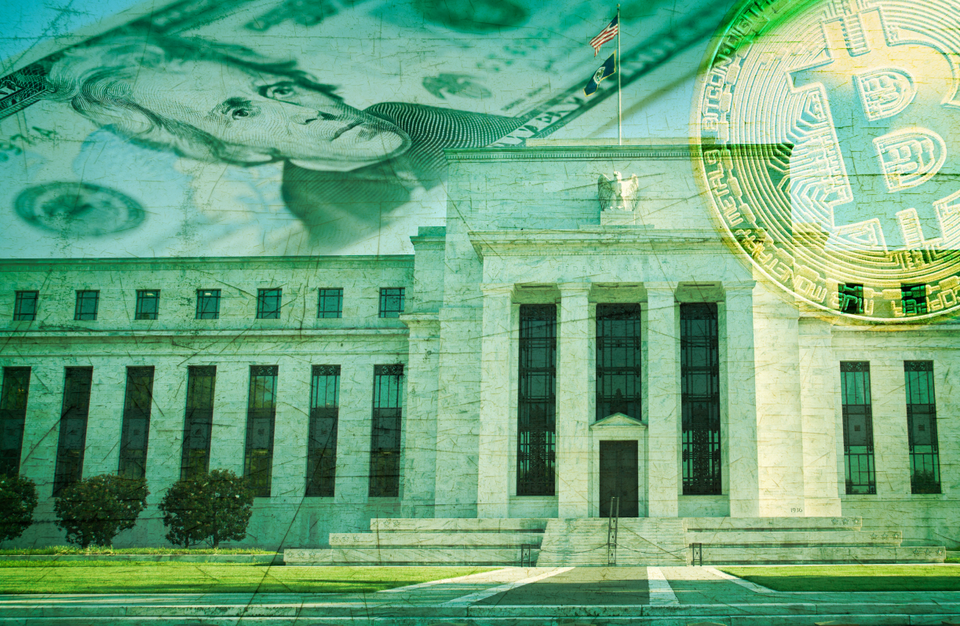Bubbles, Fed, and Crypto
The Federal Reserve has a long history of creating bubbles and deflating them. When Bitcoin matured enough, it became significantly correlated with traditional financial assets, being moved by global trends. Therefore, a question arises whether a policy reversal by the Federal Reserve in 2023 would support cryptocurrencies' rebound.
Black Monday
Monetary policy dependence on the stock market probably started in 1987. After losing 10% in the week before, on October 19, 1987, the S&P 500 index plunged by 20% in a single day. The date is commonly known as Black Monday. Facing a possible market collapse, the Federal Reserve initiated a number of support measures, including liquidity infusion and lowering interest rates. A short but informative review of the Fed's response to the crash is presented in the article “The Federal Reserve’s Response to the 1987 Market Crash (U.S. Historical)”. The rate reduction was just 0.5-1%, which is quite modest compared with future reactions to market stress episodes. The market plunge only paused and did not stop monetary policy tightening, which resumed the next year, but that was the first example of the stock market directly influencing monetary policy. Both the stock market and short-term interest rates recovered the next year, but interestingly long-term rates had never returned to the pre-crash level. October 19, 1987, was the last chance to buy a 10-year US Treasure note with a double-digit yield. One can argue it was a start of a duration bubble.
10-year US Treasury Constant-Maturity Yield (%)
Shaded area represents recessions
When Genius Failed
The next similar episode happened more than 10 years later. In the nineties, the US economy and the stock market experienced strong growth fueled by inflation moderation, new technologies, and lower military expenses. Shares performance was so good that then-Chair of the Federal Reserve Alan Greenspan famously warned about “irrational exuberance” at the stock market in the speech “The Challenge of Central Banking in a Democratic Society” in December 1996. “But how do we know when irrational exuberance has unduly escalated asset values… And how do we factor that assessment into monetary policy?” – Alan Greenspan asked in the speech. These questions were destined to become key to monetary policymaking in the coming decades.
Ironically, the moment of “irrational exuberance” warning retrospectively looks like the start of the dotcom bubble, with the Fed itself contributing a lot to it. In 1998 Asian financial crisis and Russian default led to insolvency worries about a major hedge fund, Long-Term Capital Management (LTCM). Given huge leverage, LTCM had very large positions and was considered to be too big to fail. LTCM story is popularized in the book “When Genius Failed: The Rise and Fall of Long-Term Capital Management”. The Federal Reserve Bank of New York organized a bailout of LTCM, but the Federal Reserve nevertheless decided to cut rates in order to support the economy because of possible contagion from the emerging market crisis and LTCM failure. The sum of rate cuts (0.75%) was about the same as in Black Monday, despite no market panic and very limited, if any, effect on the US economy. Ironically, the Federal Reserve promptly decided to support the stock market at the price 40-50% higher than the level when the “irrational exuberance” warning was made. After that, the dotcom bubble began in earnest. NASDAQ 100 index rallied by 36% in the fourth quarter of 1998 and doubled in 1999.
NASDAQ 100 Index in 1995-2001
The dotcom bubble burst in 2001-2002, but a subsequent recession was very mild, promoting a relaxed view on bubbles. Donald Kohn, who was one of key Fed decision-makers at that time, summarized the view in the speech titled "Monetary Policy and Asset Prices". Reflecting on the dotcom bubble and thinking about how to deal with a new housing bubble, Donald Kohn deduced that monetary policy should not take into account perceived bubbles. “If we can identify bubbles quickly and accurately, are reasonably confident that tighter policy would materially check their expansion, and believe that severe market corrections have significant non-linear adverse effects on the economy, then extra action may well be merited. But if even one of these tough conditions is not met, then extra action would be more likely to lead to worse macroeconomic performance over time than that achievable with conventional policies that deal expeditiously with the effects of the unwinding of the bubbles when they occur. For my part, I am dubious that any central banker knows enough about the economy to overcome these hurdles.” – he said in the speech.
The Courage to Act
Ironically, a relaxed view on bubbles was challenged just 2 years after it was articulated in the Donald Kohn’s speech. The housing collapse led to Lehman Brothers' insolvency in September 2008, threatening both the US and the global financial system. “The current situation is so severe that it calls for careful review of how such a crisis evolved and how we can prevent a similar situation from happening again,” – Donald Kohn admitted in a speech published in November 2008 (see “Monetary Policy and Asset Prices Revisited”).
Facing a possible collapse of the global financial system and the fastest economic drop since the Second World War, the Fed had no choice but aggressively ease monetary policy. Ben Bernanke, then-Chair of the Fed and a scholar of the Great Depression, swiftly implemented measures unprecedented in modern US history. The Fed slashed the rates to zero, pledging to hold at that level for an extended period, and engaged in purchasing assets on printed money. Dubbed quantitative easing (QE), the latter proved to be an extremely effective tool to stimulate an economy and markets. In his 2015 book, “The Courage to Act”, Bernanke argued that novel methods used by the Fed were necessary to prevent an economic catastrophe greater than the Great Depression. Bernanke did not invent QE (or in his preferred term LSAP, large-scale asset purchases), but he contemplated using it well before the crisis. For example, Fed’s tools during the Great Financial Crisis were largely the same as outlined in Bernanke’s article dated 2004 (“Monetary Policy Alternatives at the Zero Bound: An Empirical Assessment”).
Bernanke applied QE so successfully that in the mid-2010s it had become a mainstream method used by most major central banks. After that, a new market regime started, as central banks aggressively printed money every time an economy or markets seemed to be in the slightest danger. As an ultimate endorsement of QE, in 2022 Bernanke was awarded the Nobel prize in economics for his research.
A Rise of Bitcoin
During the 2008 financial crisis worries about the global financial system led to the creation of Bitcoin as a high-tech alternative to traditional finance and some kind of digital gold. In its early years, Bitcoin price skyrocketed due to wider adoption and had no correlation with the markets. When Bitcoin matured enough, it became significantly correlated with traditional financial assets and participated in both up and down global trends.
The first time Bitcoin fully participated in a boom-bust cycle of traditional financial assets was in 2017-2018. Years of QE created enough money to inflate prices of both technology stocks and Bitcoin. It took more than 15 years, but in September 2016 NASDAQ 100 finally broke above its dotcom-era high on a monthly close basis and more than doubled in the next 2 years. In February 2017 Bitcoin broke above a then-time historical maximum of $1120 (in terms of monthly close) first reached in 2013. After that, the crypto rally began in earnest as Bitcoin rose by more than 10 times till the end of 2017.
Bitcoin (Orange, Left Axis) and NASDAQ 100 Index (Blue, Right Axis) in 2013-2018
Subsequent monetary tightening by the Fed, which included burning money via quantitative tightening (QT) for the first time, deflated prices of most assets, including both stocks and crypto.
Coronavirus Over-Easing
Facing a 20% correction of the stock market and no threat of above-target inflation, the Fed pivoted from tightening at the beginning of 2019. Thus, a new cycle began, but a large-scale easing started only when the coronavirus arrived.
The coronavirus pandemic of 2020 was met with a huge monetary and fiscal stimulus. The US Federal Reserve launched unlimited asset purchases (QE), and the federal budget deficit reached a record $3.1 trillion for the 2020 fiscal year. That supported the economy during the pandemic but laid a foundation for future imbalances. Money creation was so huge that it can be easily spotted on the long-term chart. US M2 money supply increase in 2020-21 was about as large as in the previous 10 years combined.
US M2 Money Supply (Billion USD)
Shaded area represents recession
Most importantly, the stimulus largely remained in place in 2021 (primarily because of the extremely easy monetary policy) despite economic recovery. In 2020 the US Federal Reserve initiated a monetary policy review. Frustrated by persistently low inflation, it moved to a new approach, allowing inflation and employment to run higher. As a result, in 2021 the Fed ignored the booming economy and kept rates at zero level in order to boost inflation and prevent inflation expectations from slipping below the target.
Recently, the chief economist of the Bank of England said that UK officials had made a mistake in continuing their stimulus program for so long, adding that monetary policy decisions might be different “with the benefit of hindsight.” It seems a question of time before the Fed admits the same mistake.
“Everything Bubble” Rises
QE was a controversial tool from the very beginning of its use in the US. Skeptics argued it would lead to hyperinflation and dollar devaluation, but in fact, the dollar rallied against major currencies and inflation remained contained for many years. Ironically, the implementation of large-scale money-printing programs signaled a start of a multiyear bull run of the dollar (that contradicts common sense, but is perfectly in line with macro). However, QE did have an issue, which was its colossal effect on the markets. The problem was to be discovered a few years later and was contrary to early theoretical studies, suggesting that the rate forward guidance should be more powerful than QE.
Multiyear using of QE led to rock-bottom long-term rates. This trend culminated in 2020. 10-year US Treasuries yield fell from the already low level of 1.8% at the beginning of 2020 to about 0.6% in the second and third quarters of 2020, and then slowly rose to 0.9% at the end of 2020.
10-year US Treasuries Yield in 2019-2021
Real (inflation-adjusted) yield for 10 years turned negative in May 2020 and remained close to zero till the end of 2021. I think that the bond market situation in 2020 can be called a duration bubble.
Real 10-year US Treasuries Yield in 2006-2021
Shaded area represents recessions
Ben Bernanke noted that “if the real interest rate were expected to be negative indefinitely, almost any investment is profitable” (see “Why are interest rates so low, part 2: Secular stagnation”). In 2020-21 the Fed strived to test this statement in practice, and the markets responded largely in line with theory, inflating most asset prices to bubble-like levels. As a result, stocks, commodities, real estate, and crypto rallied significantly.
The S&P 500 was up about 50% from the beginning of 2020 till the end of 2021 despite the pandemic, and the NASDAQ 100 nearly doubled in the same time period.
S&P 500 (Blue) and NASDAQ 100 (Orange) in 2020-2021 (Both Are Indexed at 100 as of January 1, 2020)
Being a higher-risk asset compared with stocks, crypto soared way more than stocks. Bitcoin rallied by 6-7 times and Ethereum skyrocketed by 30 times from the beginning of 2020 till the end of 2021 (the same figures at the highs were even more fantastic).
Bitcoin (Blue) and Ethereum (Orange) in 2020-2021 (Both Are Indexed at 100 as of January 1, 2020)
Unlike previous instances like the 2000 dotcom bubble or the 2007 housing one, the 2021 bubble was so widespread that it’s often referred to as an “everything bubble”.
Be Careful What You Wish For
The Fed has been way too successful in boosting inflation. Huge money printing in 2021 despite the economy strength led to much faster price growth. In 2022 the US CPI reached multidecade highs, and inflation became a hotly debated public issue. It had not been anticipated by the Fed, so it had to hike rates much faster than it had expected. In December 2021 the Fed funds rate was expected to gradually increase throughout this year and to finish at less than 1% in December 2022. The current Fed funds rate is 4.3%. Also, the Fed engaged in the so-called quantitative tightening, directly “burning” money by reducing its balance sheet. After panicking about too low inflation and overstimulating the economy in 2020, the Fed now panics about too high inflation and is seemingly primed to overtighten.
Tighter monetary policy leads to an inverted yield curve, when long-term rates are lower than short-term rates because the market believes that current rates are unsustainably high and will be reduced in the future. Spread between 2-year and 10-year US Treasuries yield, commonly viewed as one of the best measures of policy tightness and leading indicators of a recession, in November declines to the lowest level since the early 1980s.
Spread Between 10-year and 2-year US Treasuries Yield (%)
Shaded area represents recession
“Everything Bubble” Deflates
Popping the “everything bubble” was largely a mirror image of the way it came to be. First, a monetary tightening led to much higher long-term interest rates, ending the duration bubble.
Real 10-year US Treasuries Yield in 2021-2022
Shaded area represents recessions
After that, other assets followed. Broad stock indexes declined by 15-30% this year.
S&P 500 (Blue) and NASDAQ 100 (Orange) in 2022 (Both Are Indexed at 100 as of January 1, 2022)
Like during the previous uptrend, crypto moved much more than stocks. Both Bitcoin and Ethereum lost about 2/3 of their value this year.
Bitcoin (Blue) and Ethereum (Orange) in 2022 (Both Are Indexed at 100 as of January 1, 2022)
What’s Next
The markets have increasingly priced in a policy mistake by the Fed, when steep rate hikes in 2022 lead only to a rate reduction starting sometime in 2023. Tight monetary policy in the next few quarters will likely lead to a recession and then lower inflation in the years ahead.
If the Fed will be as successful in decreasing inflation as it was in igniting inflation in 2020-21, investors need to worry about deflation. "Buy long-term Treasurys, because the deflation risk — in spite of the fact that the narrative today is exactly the opposite — the deflation risk is much higher today than it's been for the past two years," said the DoubleLine Capital CEO Jeff Gundlach, who is often referred to as a “Bond King” (see more at Business Insider article featuring his view). This call made in September was premature in hindsight, but I believe it was too early rather than wrong. Lower long-term rates may be a big tailwind for crypto in the next year.
Of course, there is a caveat, since the Fed easing is often caused by a coming economic slowdown or a recession. A recession is usually negative for stocks and positive for bonds, but what about crypto? Unlike stocks, crypto has no fundamentals linking it to economic growth or decline, so it may not be influenced by an economic slowdown and a recession (at least not as much as stocks). For example, a stock may be slammed by downgrading a profit forecast because of the weaker expected performance of the underlying business. Still, crypto is correlated with stocks and so crypto is unlikely to rally if stocks are weak.
Conclusion
The “everything” bubble in 2021 was a culmination of a cheap money era caused by the too-loose monetary policy. In 2022 high inflation forced the Fed to tighten a lot (and possibly too much), deflating the bubble. Like most other assets, crypto flew to the moon in 2021 and fell hard in 2022. Investors should understand that both price moves reflect excess volatility caused by monetary policy mistakes rather than asset-specific factors.
2023 is expected to be a turnaround year for monetary policy, likely supporting long-duration assets. That may be a tailwind for crypto too.
*This communication is intended as strictly informational, and nothing herein constitutes an offer or a recommendation to buy, sell, or retain any specific product, security or investment, or to utilise or refrain from utilising any particular service. The use of the products and services referred to herein may be subject to certain limitations in specific jurisdictions. This communication does not constitute and shall under no circumstances be deemed to constitute investment advice. This communication is not intended to constitute a public offering of securities within the meaning of any applicable legislation.




